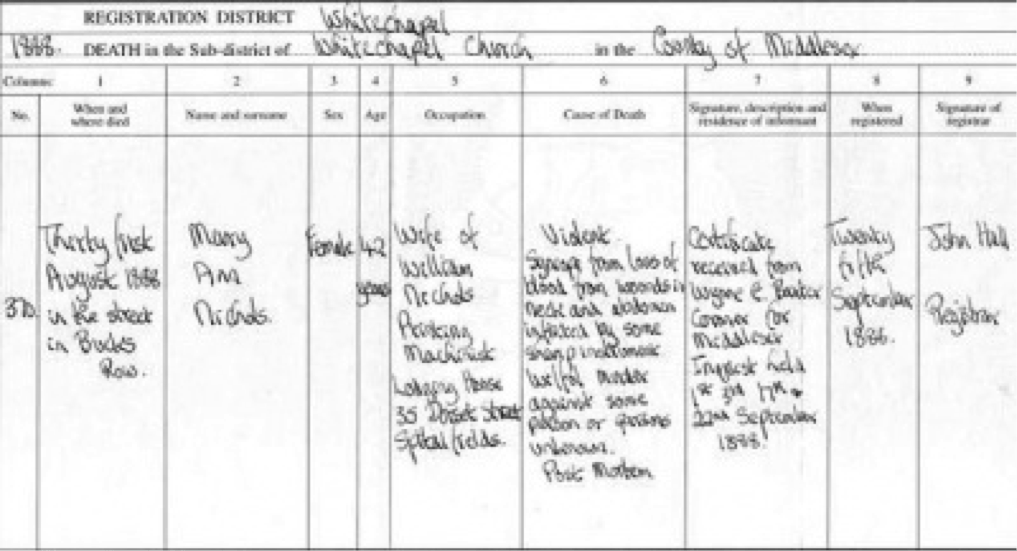Born on August 26, 1845 in London England, Mary Ann Walker was raised by locksmith Edward Walker and his wife Caroline. She married William Nichols, a printer’s machinist, in 1864; however, the couple divorced due to Mary’s drinking habits and prostitution allegations. Mary, now Mary Anne Nichols, continued practicing prostitution and was known for moving between workhouses and boarding houses, and living off charitable donations.

Prostitutes in Europe were regarded with mixed feelings in the nineteenth century. An awareness for the vulnerability of women prostitutes was fairly low and they were treated with curiosity as well as disgust. They had few economic options for making their way in the world and the women themselves were generally born into poverty and had little education or work skills. London prostitutes, especially those who operated on the streets, regularly picked the pockets of the men they preyed on. They kept an eye out for drunkards, from whom they could steal without the risk of being caught. However, this wasn’t the case with Mary as she herself spent most of her waking hours under the influence. Prostitution was very much frowned upon in London, and the women engaging in the profession were seen as the lowest of the low. It wasn’t unusual for men to beat and kill a prostitute after a ‘session,’ so when Mary Ann was found dead with her skirt lifted above her stomach, it was nothing out of the ordinary.1
The night in question was August 30, 1888. A heavy rain was falling on London during one of the coldest and wettest summers on record. Mary Ann was last seen walking down Whitechapel Road, and more than likely she was there soliciting her trade. Prostitution was a very dangerous profession one hundred thirty years ago. With no proper policing and the women themselves looked upon as animals, people would do with them as they pleased. No wonder the infamous ‘Jack the Ripper’s’ victims were all prostitutes.2 They were easy targets, and he was able to get away with murder.
Nichols was often found in the lodging house on 18 Thrawl Street; however, on this specific night she was knocked back due to a lack of money.3 Mary wasn’t fazed by this though, and was on her way back to her ‘office,’ the streets. At 2:30 am she ran into Emily Holland, another worker, who described Mary to be drunk and staggered against a wall. She told Emily that she was off to find another ‘punter’ in an attempt to get her ‘doss’ money in order to rest her head that night.4 One can’t help but think that Mary was selected by Jack because of her drunkenness and through no fault of her own she was destined to a brutal ending because she was such an easy victim. Emily Holland was the last known person to interact with Mary, and only one hour later, at 3:40 am, the latter was found cold and lifeless on the side of Bucks Row, a mere ten minutes walk from where the interaction took place.5

Constable Thain and Sergeant Kerby both passed down Bucks Row at 3:15, but reported nothing out of the ordinary. One must wonder what Nichols was doing from 2:30 to 3:40. She was only ten minutes away from Bucks Row, yet was found dead there seventy minutes later. Another thought would be: what was Jack the Ripper doing during that time. 6
Nichols’ body was initially found by two workmen, who both decided to leave her lying, as they didn’t want to be late for work. However, they let a police officer know her whereabouts on their way. Major bruising was found on Mary’s body and five of her teeth were missing. Investigators put this down to the struggle. Nevertheless, there were several deep cuts along her abdomen, which shows that her attacker enjoyed closeness with his victim, whom he supposedly raped and then mutilated. One can only speculate on why these cuts were made as they were, in no pattern, and didn’t relate to anything. As the first kill, maybe Jack was experimenting with Mary, and she was some sort of sick puppet in which his fantasies could be played out.7

Mary was buried on Thursday, September 6 of that year in the City of London’s Cemetery.8 Two days later, another of Jack’s victims, Annie Chapman, was found in the back garden of a London flat.9 Her womb had been removed and her body left horrifically mutilated. Jack the Ripper had indeed struck a second time. He wasted no time in preparing his second victim, yet this time it was more brutal than the first. One may wonder if Jack had attempted to remove Mary’s womb, but was perhaps disturbed and fled the scene before he could complete the operation.10 Jack the Ripper’s third victim was Elizabeth Stride. She was found at 1:00 am in Dutfield’s Yard, London. The fact that her throat had been cut, but the rest of her body had not been touched, led to speculation that her killer had been interrupted. This links with Mary Ann’s case because it is believed that Jack was also interrupted while working on her. One may believe that Jack liked the excitement of being caught, as he seemed to carry out his kills in the middle of streets. The fourth victim was found in Mitre Square in the City of London at 1:45 am. Catherine Eddowes was savagely mutilated by The Ripper, as her face was torn off and her uterus was missing along with her kidney. Clearly, Jack had not been interrupted this time. On November 9, the body of Mary Kelly was found in her room in Miller’s Court at 10:45 am. She had been virtually skinned to the bone and many experts believed that she was Jack the Ripper’s final victim. This was a fitting finale for the sick monster, as he chose a private area in order to carry out his most disturbing kill of all.11
For well over one hundred years since the time of the murder of Mary Ann and the rest of Jack’s victims, the identity of the killer has been regularly questioned, with nearly one hundred suspects having been named in the process. While many theories exist, none of them have proven to be indisputably convincing. Many think the Ripper was a commoner, possibly a butcher or other tradesman, who lived locally and was employed during the week, explaining why the murders occurred on or near the weekend. A lot of experts also agree that the Ripper was a local to Whitechapel. One of the most compelling suspects was Thomas Hayne Cutbush, who was a violent youth diagnosed insane at the time of the murders in 1888, and was believed to be wandering the streets of London throughout the time of the killings. Subsequently, the murders then stopped after Cutbush was locked up. Disappointingly, this information, along with more evidence, did not prove that Cutbush and Jack the Ripper were the same man; but there was enough evidence to keep Cutbush on the suspect list.12
The finger of suspicion was first pointed at Cutbush in 1894, by The Sun newspaper.13 The article claimed that despite the popular theory of the Ripper being dead, he was in fact a mental patient. The Sun’s detailed description clearly resembled that of Cutbush. The suspicion was that the Metropolitan Police covered up his guilt to avoid the embarrassing outcry that would have followed if the country’s most feared serial killer was found to be Superintendent Henry Cutbush’s nephew. Henry was a high ranked officer, whose reputation could have been seriously damaged if his relative was found to be Jack the Ripper. This is another reason why Thomas Cutbush was actively considered as a suspect.
Some named Cutbush as the No 1 Ripper suspect, but others have strongly denied this theory. Its main weakness is that the last known Ripper victim died in November 1888, at the end of the eleven week killing spree. If Cutbush was the killer, it seems odd that he would commit five murders over such short a period of time, stop for more than two years, and then commit one more assault, in which his victim survived. But there is almost no chance that the case will ever be solved. Thomas Hayne Cutbush remains top of the suspect list.14
It’s an eerie thought that this case will never be solved and even if it is, there is no one to suffer the consequences. It’s even scarier to think that there may currently still be serial killers on the run now that will also never be found and charged for their crimes. There will never be any justice for Jack the Rippers victims, but they can be certain they will never be forgotten.
- Mary Spongberg, The Body of the Female Prostitute in the Nineteenth-Century (New York, NY: New York University Press, 1997), 83-85. ↵
- Encyclopaedia Britannica, July 1998, s.v, “Jack the Ripper, English Murderer,” by John Phillip Jenkins. ↵
- Knocked back means dismissed. ↵
- A punter is a client. Doss is rent. ↵
- Stephen P. Ryder, “Casebook Jack the Ripper,” Victims: Last Addresses, August 14, 2009, 2, www.casebook.org/victims/polly.html. ↵
- Stephen P. Ryder, “Casebook Jack the Ripper.” Victims: Last Addresses, August 14, 2009, 2, www.casebook.org/victims/polly.html. ↵
- Salem Press Encyclopedia, January 2016, s.v. “Jack the Ripper,” by Cait Caffrey. ↵
- Death Certificate: no.370. 25 September, 1888. http://www.casebook.org/victims/polly.html ↵
- A back garden is a backyard. ↵
- William D. Rubenstien, “The Hunt For Jack the Ripper,” Ripper Diaries, (May 2000): 1-3. ↵
- Richard Jones, “Jack The Ripper 1888,” Victims (13 March 2016): 3. ↵
- Andy McSmith, “Madman’s notes throw new light on Ripper case,” The Independent article London, (19 November 2008). ↵
- A tabloid newspaper published in the United Kingdom and Ireland. ↵
- Richard Wheatsone, “Ripping Discovery,” The Sun (16 September 2017). ↵



211 comments
Arieana Martinez
I had heard of Jack the Ripper, but never looked in depth into his killings or women that he preyed upon. This article was wonderfully articulated, and the progression of the article was on point. I was hooked the entire time and could not stop reading once I started. Although the story of Jack the Ripper himself is very disturbing and scary to think about, I loved the suspense portion of the article and the mystery behind it all, as he was never caught. Or was he? We’ll never know, adding to the pull behind the story.
Annissa Noblejas
Prostitutes continue to view as lower than life and make for easy targets. Many women who choose this profession have very few options for making money to support themselves. Jack the Ripper was a monster who preyed on women, those of who never received justice. The lack of any known forensic techniques and relying solely on witness testimonies has rendered these tragedies to the permanent cold case files.
Julia Deais
This article is very well written. I have heard of Jack the Ripper but I never really knew what happened or who he was. I am surprised that they have not solved the murder case and I can not believe the monstrous acts that he committed. I think it was Cutbush because they said he was insane and no sane person would commit these monstrous acts.
Lilliana Canales
I’ve heard a theory of Jack the ripper being a female, however after reading this article, it sounds like Jack the ripper may have been someone who was part of a church, and as the article mentioned, perhaps someone from the whitechapel. Should the real criminal have been a church figure, their motive may have been just trying to rid the world of sin and impurity and the wombs cut open may have been to signify that a woman should only be used to have children but prostitutes were putting that ability to waste. Had a victim of the ripper’s been found today, forensics would have found the rape evidence and a suspect in custody or even charged and punished.
Micaela Cruz
I had heard a few stories of Jack the Ripper and his story always fascinated me. However, the way he murdered his victims was so horrific. I don’t find it surprising that the crimes were never solved as using DNA to solve crimes was not used during the 1800’s but if it was common, I wonder if today we would actually know the real identity of Jack the Ripper? It was interesting to read about how his murders took place but that his last murder took place in the morning… I wonder why?
Sienna Guerra
I find it interesting that I am commenting on this article exactly a year ago today. But regarding this article, I remember a person in my forensics science class in high school and they presented on Jack the Ripper. This case was shocking to know that the crimes he committed were never solved and it is sad to know that the women that were hurt do not have the chance to protect other women from this type of crime knowing that it may still be happening today.
Reagan Meuret
I have not heard a whole lot about Jack the RIpper, but it is chilling to know how much terror he brought to people especially this woman. I just think its hard to imagine someone doing such a thing, and it is even worse to know that he got away with it. I am glad this article was able to inform me and bring me up to date with Jack the Ripper.
Cooper Dubrule
Unsolved cases are a very interesting subject. I enjoyed the point of view and approach the author took to this article. What I like most about these cases is the morality questions that come with them. The choices of victims and especially in this case could be based off of something that the suspect saw as immoral and thus he is making his judgement on them.
Caden Floyd
I have heard the name Jack the Ripper before, but I have never really learned about him, all I know is that he was a very dangerous and scary man. It’s crazy to think that he has never been caught. Many people have been questioned and there have been hundreds of suspects, but all of them were dead ends. Who knows, maybe they did find him but he somehow managed to remain anonymous. It’s sad to think that the women he murdered will never truly rest in peace knowing he was never caught. This article was very detailed and I think that is why I enjoyed it so much.
Jennifer Salas
I’ve never really enjoyed reading crime articles but this story pulled me in. I’ve heard about Jack the riper before but never did any research on him. I was shocked when I learned that the crime was never solved and to this day we’re left wondering about all the murders he committed. I wonder if this were to occur today, would he have been caught? Maybe if they had the tools and resources that we have now they would’ve solved the case.